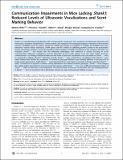| dc.contributor.author | Wohr, Markus | |
| dc.contributor.author | Roullet, Florence I. | |
| dc.contributor.author | Hung, Albert Y. | |
| dc.contributor.author | Sheng, Morgan Hwa-Tze | |
| dc.contributor.author | Crawley, Jacqueline N. | |
| dc.date.accessioned | 2011-09-02T14:59:27Z | |
| dc.date.available | 2011-09-02T14:59:27Z | |
| dc.date.issued | 2011-06 | |
| dc.date.submitted | 2011-01 | |
| dc.identifier.issn | 1932-6203 | |
| dc.identifier.uri | http://hdl.handle.net/1721.1/65603 | |
| dc.description.abstract | Autism is a neurodevelopmental disorder with a strong genetic component. Core symptoms are abnormal reciprocal social interactions, qualitative impairments in communication, and repetitive and stereotyped patterns of behavior with restricted interests. Candidate genes for autism include the SHANK gene family, as mutations in SHANK2 and SHANK3 have been detected in several autistic individuals. SHANK genes code for a family of scaffolding proteins located in the postsynaptic density of excitatory synapses. To test the hypothesis that a mutation in SHANK1 contributes to the symptoms of autism, we evaluated Shank1−/− null mutant mice for behavioral phenotypes with relevance to autism, focusing on social communication. Ultrasonic vocalizations and the deposition of scent marks appear to be two major modes of mouse communication. Our findings revealed evidence for low levels of ultrasonic vocalizations and scent marks in Shank1−/− mice as compared to wildtype Shank1+/+ littermate controls. Shank1−/− pups emitted fewer vocalizations than Shank1+/+ pups when isolated from mother and littermates. In adulthood, genotype affected scent marking behavior in the presence of female urinary pheromones. Adult Shank1−/− males deposited fewer scent marks in proximity to female urine than Shank1+/+ males. Call emission in response to female urinary pheromones also differed between genotypes. Shank1+/+ mice changed their calling pattern dependent on previous female interactions, while Shank1−/− mice were unaffected, indicating a failure of Shank1−/− males to learn from a social experience. The reduced levels of ultrasonic vocalizations and scent marking behavior in Shank1−/− mice are consistent with a phenotype relevant to social communication deficits in autism. | en_US |
| dc.description.sponsorship | National Institute of Mental Health (U.S.) (Intramural Research Program) | en_US |
| dc.description.sponsorship | Simons Foundation | en_US |
| dc.language.iso | en_US | |
| dc.publisher | Public Library of Science | en_US |
| dc.relation.isversionof | http://dx.doi.org/10.1371/journal.pone.0020631 | en_US |
| dc.rights | Creative Commons Attribution | en_US |
| dc.rights.uri | http://creativecommons.org/licenses/by/2.5/ | en_US |
| dc.source | PLoS | en_US |
| dc.title | Communication Impairments in Mice Lacking Shank1: Reduced Levels of Ultrasonic Vocalizations and Scent Marking Behavior | en_US |
| dc.type | Article | en_US |
| dc.identifier.citation | Wöhr, Markus et al. “Communication Impairments in Mice Lacking Shank1: Reduced Levels of Ultrasonic Vocalizations and Scent Marking Behavior.” Ed. Wim E. Crusio. PLoS ONE 6.6 (2011) : e20631. | en_US |
| dc.contributor.department | Massachusetts Institute of Technology. Department of Brain and Cognitive Sciences | en_US |
| dc.contributor.department | Picower Institute for Learning and Memory | en_US |
| dc.contributor.approver | Sheng, Morgan Hwa-Tze | |
| dc.contributor.mitauthor | Hung, Albert Y. | |
| dc.contributor.mitauthor | Sheng, Morgan Hwa-Tze | |
| dc.relation.journal | PLoS ONE | en_US |
| dc.eprint.version | Final published version | en_US |
| dc.type.uri | http://purl.org/eprint/type/JournalArticle | en_US |
| eprint.status | http://purl.org/eprint/status/PeerReviewed | en_US |
| dspace.orderedauthors | Wöhr, Markus; Roullet, Florence I.; Hung, Albert Y.; Sheng, Morgan; Crawley, Jacqueline N. | en |
| mit.license | PUBLISHER_CC | en_US |
| mit.metadata.status | Complete | |
